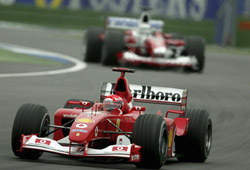
"He brakes and turns in very smoothly," he says. "He is off the brakes lightly and slowly. He turns the steering little by little, but can correct things very rapidly if they go wrong. Then he gets on the power early and slowly feeds it in, controlling it with the steering. His control is so sensitive I think he can feel what all four of the wheels are doing individually."
Comparisons have been made this year between the five-time champion and McLaren's new boy Kimi Raikkonen. Their style seems to defy traditional belief that there is either 'fast in/slow out' or 'slow in/fast out' and never the twain shall meet. In fact they have a style that can only be described as 'fast in/fast out'.
Raikkonen turns in a fraction early, reaches the inside of the track carrying the speed in, then manages the minutest of flicks to oversteer the car into the perfect trajectory for the exit. That way he is early on the power. Except it is not a slide and, somehow, miraculously he maintains the momentum. Team mate Coulthard takes a wider, more traditional line. He either brakes earlier or goes in deeper to scrub off the speed. Both cost time.
"You have to be very confident in yourself to be able to do that - it requires incredible car control," said former Indy lights champion Steve Robertson, who is also Raikkonen's manager. "Generally it is true to say that having an understeering car is the way most drivers prefer it. It's safer. But if you can do it, having slight oversteer is faster. But most drivers' couldn't live with it. I couldn't."
McLaren technical director Adrian Newey agreed: "I don't think anyone likes oversteer but the really good drivers cope with it better. It is that way with all the top drivers: Senna, Schumacher, Raikkonen."
The reasons are obvious: the punishment for a fractional miscalculation with oversteer is a rear end spin and a lot of time lost getting back on the track, while a touch too much understeer only results in the nose continuing to go straight on rather than turn the bend. The solution is simple: lift off the power. But with oversteer, lifting off the accelerator is not the solution. Quite the reverse. If you lift off you can lose the grip at the back and make the situation worse. The solution is to be found with the steering wheel.
"I don't think Kimi does that intentionally," said Button. "It is just that he sets up his car a little bit oversteery." The BAR driver believes all the analysis from those standing on the sidelines is phooey, but the in-cockpit television shots are a different matter.
"With in-car cameras you can see Michael looks really similar to Jarno, they are both smooth on entry but they are not in same car so it's difficult to compare. There are always going to be slight differences in the line drivers take unless they are in the same car. If there are different then, someone is going the wrong way."
There are exceptions. Takuma Sato shows incredible control, but has crashed frequently and were it not for his control it would almost certainly have been far more. "He's not learning," said one driver. "He's just on the ragged edge trying to control the car. He's all over the place and can't possibly be learning anything. He's too ragged."
"Overdriving is a common problem," says Symonds. "Paradoxically some drivers would go faster if they slowed a little." But the basic laws of physics apply. "The closer you are to that verge of instability the quicker you can make the car go," he adds. Oversteer takes you right to the edge of the precipice, understeer gives you a margin for error.
Check back soon for the third and final part of this feature.